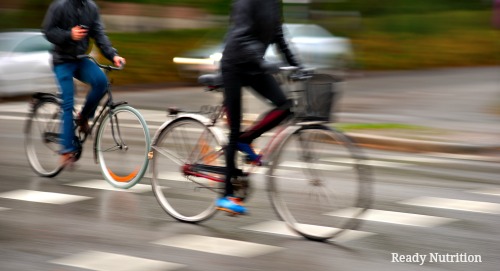
Cycling is great for your body and great for the environment. People who ride their bicycles regularly have better cardiovascular fitness, less body fat, increased energy, and they experience less depression. These are all ideal characteristics for being conditioned in a SHTF situation. Cycling to work instead of driving saves close to 10% of your household emissions and biking combats noise pollution, traffic, and uses far less rubber than what is needed for car tires. It makes sense that anyone who is interested in having a sustainable lifestyle would also be interested in traveling by bicycle as much as they can.
Why Cycling Matters in a SHTF Situation
In addition to health benefits, knowing how to cycle and having the necessary gear can come in handy in a dire SHTF situation. I recently read an article about how traveling by bike is your best bet for surviving the zombie apocalypse—the article was a bit of a joke, but it got me thinking seriously about bugging out and how to travel safely in a potentially dangerous situation.
Riding a Bicycle Lets You Avoid Traffic: First of all, anytime there is an emergency, from a severe weather event to a terrorist threat to a fire, traffic becomes an immense and literal roadblock. You won’t be limited to roads at all if you have a bicycle. Being able to take alternate routes means getting the heck out of Dodge faster—of course, you’ll have issues with covering long distances, but people stuck in hours of traffic will too.
Riding a Bicycle Does Not Require Fuel: There’s also the issue of getting gas and maintaining your energy source for your car. Sure, if you’re prepared, you’ll have a few extra tanks on hand, but what happens when that dries up? In a national or worldwide SHTF situation, gasoline will be among the first resources to go scarce. When the gas is gone, even if drivers are able to power through traffic and use their preps, it’s only a matter of time before they have to abandon their cars and continue their travels on foot.
Bikes are Easy to Repair: A bicycle is a straightforward machine that requires only a slight bit of research to repair. You don’t want to be worrying about your engine or oil changes when you’re on the run.
You Can Still Carry Cargo: If you’ve traveled to Indonesian countries you’ve seen how much gear (or how many people!) can be packed onto a single bicycle. Having a basket or rack is an easy and affordable way to make your bike more emergency friendly. Even just having a simple set up for your bug-out bag and some of your preps will make a huge difference.
You Can Accommodate Children on a Bicycle: If forced to abandon your car, having smaller children means that they slow you down, and if they aren’t willing to walk you will find yourself in a terrible situation indeed. Carriers or trailers like this one mean your child can be sleeping soundly while you travel.
Riding a Bike is Better for Your OPSEC Situation: Bicycles are stealth and silent when you are riding them and are reliable in an off-grid situation. They are small and easy to camouflage–they can even be pulled up into a tree or stashed behind some bushes at a moment’s notice.
At the very least, understand that you cannot rely on your vehicle in a true SHTF situation if you have to flee your home. Loading up your trunk with preps could potentially be a waste of time—instead, you might do well to learn how to ride a bike and be sure one is packed in that trunk of yours.
This article was originally published at Ready Nutrition™ on November 12th, 2016






